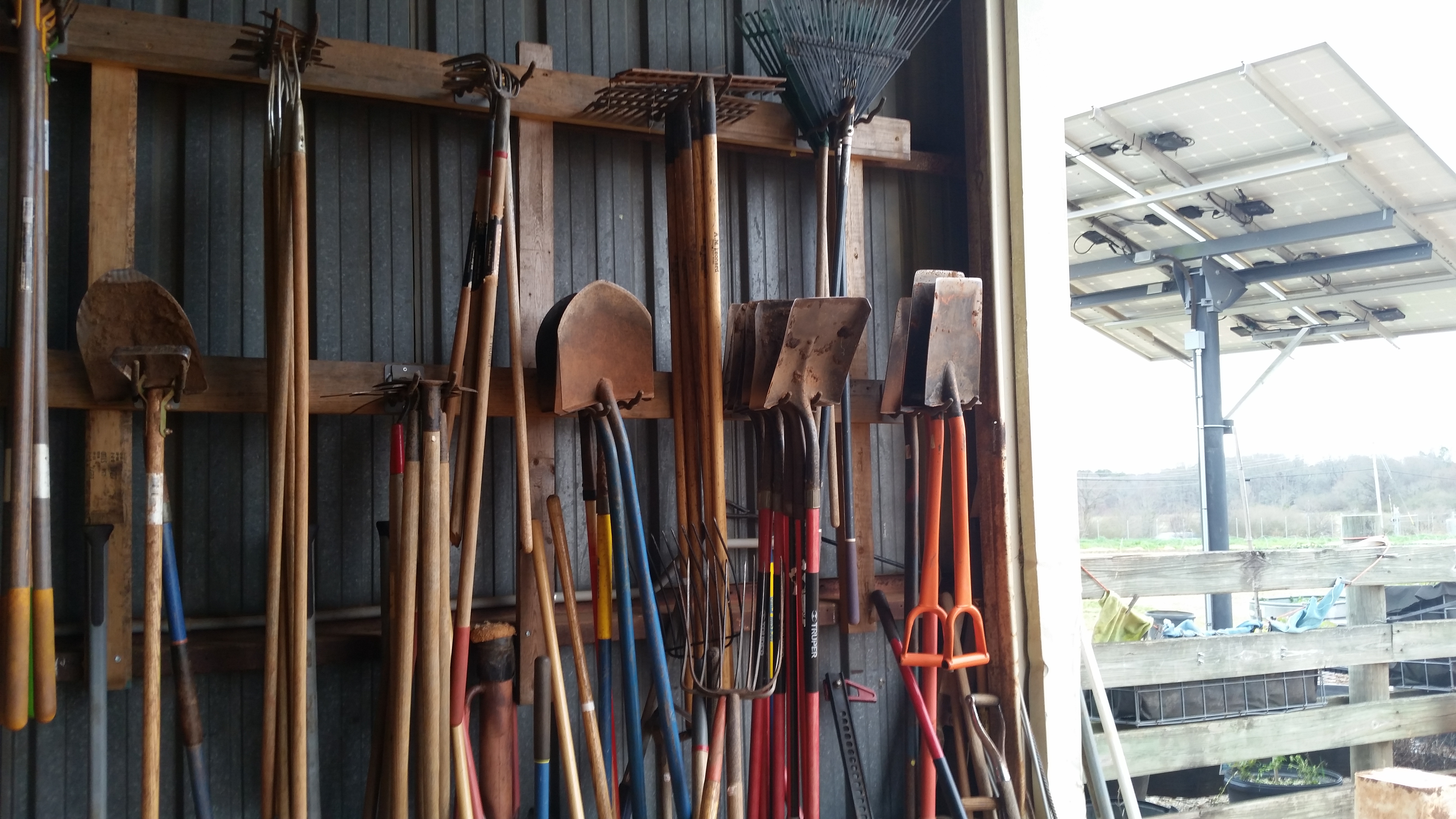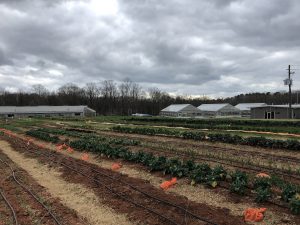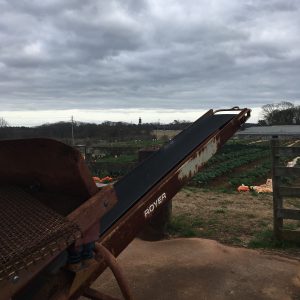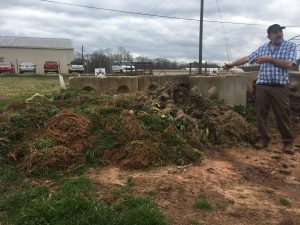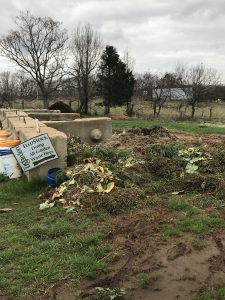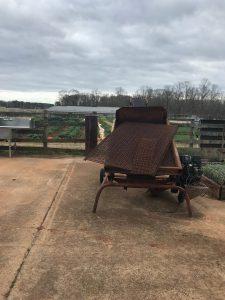- Start basic: In this picture, while some may see a pile of garbage, I see a compost pile. Mainly, there are food scraps, sticks, leaves and plants.
- What I notice in this picture: I took this picture from above the compost pile, so it appears to blend in with the grass around it. You can’t see the size of the pile from this picture, but it was a lot smaller than I was expecting it to be.
- What this picture makes me think about: When I was younger, I went to Israel with my family and visited my dad’s cousin’s farm. The UGArden brought back some of the memories I have about the farm in Israel as they looked very similar. It also makes me think about how long the composting process actually takes. Prior to visiting the UGArden, I thought it took around a month or two for a compost pile to decompose, but I learned that it takes closer to six months for a compost pile to fully decompose.
- When I look at this picture, I feel: Like I can still smell how bad the compost pile smelled. Because I learned so much about composting, I understand that I can help compost very easily and make a difference.
- I think this picture is about the many different foods and plants people can use to help compost.
Category: UGArden Tour
In this photo blog, post a photo form the tour and provide answers to the following questions:
Start basic: In this picture, I see….
What I notice in this picture: [One thing that really struck you.]
What this picture makes me think about: What do you think someone would interpret this at first? (Either through your writing or a photographic image.)
When I look at this picture, I feel:
I think this picture is about:
UGArden – Blog Post #2
In this picture . . .
I see the tools of a trade, an surprising number of shovels, rakes, and hoes. Protected from the elements, but always ready to be used. The wear and tear from years of loving use, evident from the dirt-stained metal, the worn out wood, and the carefree manner with which they hang.
I notice tools for which I don’t even know the name. Devices used for jobs so far removed from the world which I know that I couldn’t even begin to guess what their intended purpose is. Instruments of destruction designed to obliterate any resistance to their task.
I think of the way in which these tools have helped their masters. Reducing their workload and easing their strain, these tools have saved thousands of hours of back breaking work.
I feel content knowing that these tools produce good food. That at the end of a season, the reward is something worth laboring over. Biting into some watermelon on a hot summer day, or drinking warm tea during a late night study session. It all begins with these tools.
This picture is about what it takes to grow crops. It represents the effort, knowledge, and time it takes to nurture something which
A trip to UGArden
On Thursday, February 15, we took a trip to UGArden. This this trip got me onto the last bus route I needed to have taken a trip on all of the university’s bus routes (Riverbend South Milledge). As soon as I arrived, I was taken aback by just how different things look only two or three miles outside the city. It reminded me a lot of Americus, the city in southern Georgia where I grew up. So that’s really what I saw in the picture below:
Having grown up surrounded by farmland, seeing something like this reminded me just how much the state of Georgia depends on agriculture.
I was immediately curious where the produce from UGArden goes, and was glad to hear that it gets given for charitable purposes. And after hearing Professor Berle talk about composting, it made me feel reinvigorated about protecting the environment.
UGArden
In this picture I see the old composting device as well as some of the garden’s current crops growing in the background. When we first saw the compost system at the garden, it struck me just how much the people cared about the work they did to keep their plants healthy, to minimize the waste they create, to the point where they’ll do their best to utilize even older machines that they need to bear rebuild in the hopes that that machine might improve their system in speed or effectiveness. It made me think about all the hard work out in to growing each and every plant – I can’t help but feel others would interpret this image as equally caring, to see such pretty plants alongside such worn equipment. Even personally I feel simple happiness that someone else could have found such joy and love for the earth and their crops to befit the intense effort put in to making the farm as efficient as possible. The trip and this picture have inspired me to do my best to return to the garden, next time as a volunteer, to help in making it the best it can be.
UGArden-Bradley Howard
In this picture, I see the compost sifter from the UGArden that the guy showed us on our visit. What I really notice in this picture is just how old this equipment is with most of it being rusty. If I remember the man correctly, he said that this machine was somewhere around thirty years old. This picture and this machine really surprise me, and I feel upset that we are using such older equipment in our school’s garden and the compost for the garden. When I look at this picture, I feel upset because I believe that we should have more money going towards this great initiative on our campus to maybe get better, newer, more innovative equipment and possibly expand the project further. This machine, to me, shows that more funds should be allocated to the UGArden.
Josh Marcinczyk | UGArden
- Start basic: In this picture, I see a heap of garbage. Mainly, there are food scraps and sticks and leaves and plants. Overall, it is a sort of compost system.
- What I notice in this picture: The pile, and system as a whole, are a lot smaller than I imagined they would be. Also, the heap blends in very well with the surrounding natural environment.
- What this picture makes me think about: What do you think someone would interpret this at first? This makes me think about the times that I had to help my parents with yard work. Specifically, when we had to pull up plants/weeds, because the pile appears very weed looking to me.
- When I look at this picture, I feel: Rural and uneasy. This picture is characteristic of my thought of a farm. We were far from the center of campus the area seemed very rundown and unfamiliar and made me a little unsure.
- I think this picture is about: UGA’s mission to give back to the community and environment. Their compost system may not be huge, but it is something and you have to start somewhere. It only takes a little bit from everyone. Teamwork makes the dreamwork, and UGA is doing their part.
Allaina Siler UGArden Post
Image: Something that surprises me about the facility
What surprises me about the facility was their large-scale composting, and how composting sometimes involves more than just dumping scraps in a spot. Active composters keep the material separated into zones based on how decomposed it is, and sometimes the material has to cycle through another time to be done.
In this picture, I see the UGArden speaker and professor showing the completely plant-based compost area of the garden. When looking at each section from left to right, the compost material gets less and less course, and it decomposes to create rich compost material to aid crops.
One thing that really strikes me in this picture is the drastic change in the size of the piles (going from left to right). It’s surprising how such a large mass of material through decomposition yields so little compost material in the end.
This picture makes me think about how long it truly takes for the plant-based material to fully decompose for composting. I thought it would take at the most two weeks for it to graduate on and on in the different stages, but it usually takes up to months, and for full decomposition, sometimes years. I always thought that it would take around six months at the most to break down, but in this intermediate composting method, it takes much longer.
When I look at this picture, I feel called upon to start composting. I know it would be hard to do it in my dorm room, but by seeing the piles in person, I feel that it’s important that I do my part to not waste scraps and plant material. If I don’t compost, the material will just end up in landfills and be put to no use, so it’s important that I do the right thing to help both crops and the environment.
I think this picture is about the visible process of composting. I had never really seen in up close and in person, as my family doesn’t compost, so the visual was nice. And, his commentary about how they facilitate this process was really educational as well.
UGArden – Harina Som

- In this picture I see a pile of compost and the steps the compost pile goes through to get to the end goal which can be seen towards the back of the picture. The end goal is a pile of decomposed material which is essentially fertlizer.
- One striking thing I noticed in this picture was the amount of work a pile of compost has to go through to become a pile of fertlizer. In this picture you can see 4 seperate bariers before the pile at the end, this is essentially 4 seperate steps the pile in the front goes though so it can be used as fertilizer.
- I think when someone looks at this picture first, they will just see the pile in the front which they will assume to be trash and won’t really see the ending result which is a compost pile. Before the vist, if I saw this picture, I would not notice the amount of work that goes into composting, I always just thought the compust pile is formed by itself by putting organic material in a pile. I did not know there were so many factors that have to be controlled sush as sunlight, moisture, temperature, ext..
- When I look at this picture, I feel good to be a part of the UGA community. This garden took what was once used as barriers during war and now uses them as barriers between each stage while preventing high moisture and control temperatures. They are also essentially taking organic waste material and making it useful by practicing composting, so they can put that back into the system to get more fruitful results. I love how the UGA community practices sustanibility in every little way.
- I think this picture is really about showing the work behind composting while illustrating each step in detail. Then showing the timline of composting from the first stage to the final stage. This picture also shows the variety of things that can be composted and if you really look into it — you can see that this pile does not involve animals except for egg shells. This shows that the pile is carbon heavy and nitrogen light because it is plat based.
UGArden
- In this picture, you can see UGArden’s compost pile and the barriers they use to divide the various stages.
- One of the most striking things about this picture is the size of the compost pile. It’s much more spread out and larger than I initially expected it to be. The pile that can be seen at the front of the photo is only the first step in the composting process. Once the first pile has been churned up and properly composted it moves to the next barrier and stays there for a while.
- I think if someone saw this picture, they may be able to recognize it as a compost pile. However, they may not know all the other steps that will be involved in the process. Before visiting, I just assumed that you leave the compost in one large pile like the one seen in the photo. I had no idea it had to be moved around and put in different stages.
- When I look at this picture, I feel proud of all the innovation that UGArden has accomplished. Those barriers seen in the photo were once barriers for the Air Force building. Now, they serve as a backboard to help scoop up the compost more easily, as well as prevent rain from running downhill and dampening the compost piles.
- I think this picture is about the amount of work and time that really goes into composting. The various stages barricades help show just how many different stages of decomposition a pile of compost must go through before it’s actually ready to be used. It also shows just how many different things can be composted. The pile is full of a wide variety of scraps and plants.
UGArden – Delaney Williams
The picture’s focus is on an old compost sifter the has been donated to the UGArden from back when UGA first started it’s composting initiative. Different size screens are perched atop the sifter in preparation for future use. In the background are rows of vegetables, and the mushroom greenhouses sit at the bottom of the hill.
One aspect of the picture that really struck me, and about the farm in general, is how worn and home-made everything on the farm seemed to be. While the professor assured us the sifter was in perfect working condition and seemed overall extremely excited about its possibilities, it was clear that the simple piece of machinery doesn’t compare to the main composting center’s setup. In regards to the composting pile, it is obviously not as professional as the professor would like it to be, but the lack of understanding and funding has not dampened his passion for the subject.
The image makes me wonder about the accessibility of composting on campus would really look like. Even with such a jury-rigged setup, there is a process that must be followed and I wonder if students would really be open to composting. I also wonder what students would see when viewing the sifter, and if they would be interested in going farther than just saying oh there’s a rusted piece of farm equipment.
When I look at the picture, I remember seeing the obvious care and pride that the professor has for the farm. Even though some of the fields seemed a little messy, it was clear that everyone who volunteers at the UGArden holds and obvious pride for the work they are doing and it showed in every aspect of the tour.
I think this picture encompasses what UGArden hopes to achieve on campus. They have found a way to start working towards an environmentally friendly goal utilizing every aspect of the farm that they can, which is absolutely admirable. I also think about how much they could achieve if they were able to spread their message farther, or if they had proper funding.
Overall, I really enjoyed our visit to the UGArden and I might look into volunteering in the near future.


